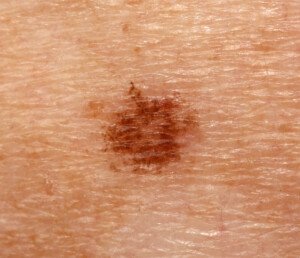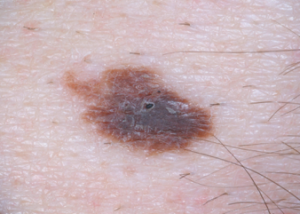A mole or nevus can look identical to a lentigo.
Both a mole and a lentigo have the potential to develop into melanoma, a skin cancer that kills thousands of Americans every year.
But from a cellular standpoint, is there a difference between a mole and a lentigo?
“Nevi and lentigines are different lesions,” says Dr. Jennifer Gordon, who is board certified by the American Board of Dermatology and practices at Westlake Dermatology in Austin, Texas.
“Nevi” is the plural of nevus, and “lentigines” is the plural of lentigo.
Dr. Gordon continues, “Nevi are made of nests of melanocytic cells [which produce the pigment melanin], and lentigines are just an increase in pigment in normal keratinocytes.”
A keratinocyte is a cell in the top layer of the skin that produces a protein called keratin.
“Lentigines are what we think of as ‘freckles,’ and they can come and go with sun exposure during our entire life.
“Nevi are moles and are what have the potential to turn into melanoma. These are also the cells that are melanoma regardless if they were a previous nevus.”
A Mole and a Lentigo Are Quite Different from Each Other

Common mole, Source: cancer.gov

Lentigo. Shutterstock/Dermatology11
“There are many characteristics that differentiate a lentigo from a nevus and often we can tell the difference,” says Dr. Gordon.
“Obviously you cannot always tell, and if the lesion is suspicious we would biopsy either way.
“Characteristics that make the lesion suspicious are if it is new, changing, bleeding or different than the patient’s other pigmented spots.
“There is no data that removing pigmented lesions that are NOT suspicious is prophylactic for preventing melanoma, and thus ‘de-moling’ is not recommended.”
In summary, don’t worry if you have a lentigo vs. a common nevus or mole.
You should conduct monthly self-skin exams (include the bottoms of your feet, behind your ears and inside your belly button) for any suspicious changes or new moles.

Dr. Gordon’s interests include medical dermatology, particularly the treatment and prevention of melanoma and other skin cancers in athletes. For 2016, 2017 and 2018 Texas Monthly Magazine selected her as one of the Texas Super Doctors Rising Stars.
 Lorra Garrick has been covering medical, fitness and cybersecurity topics for many years, having written thousands of articles for print magazines and websites, including as a ghostwriter. She’s also a former ACE-certified personal trainer.
Lorra Garrick has been covering medical, fitness and cybersecurity topics for many years, having written thousands of articles for print magazines and websites, including as a ghostwriter. She’s also a former ACE-certified personal trainer.
.










































